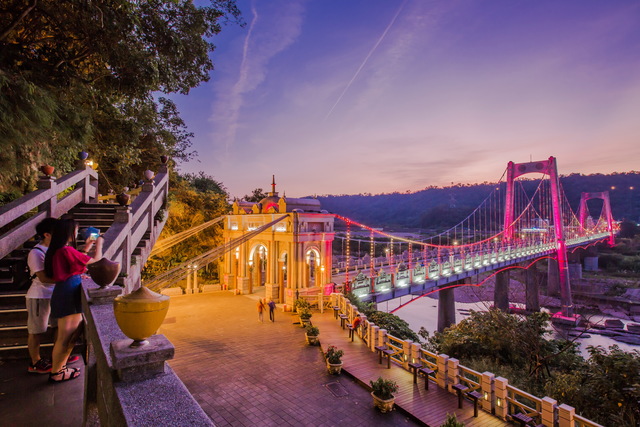Daxi Bridge Introduction
The Daxi Bridge, spanning across the Dahan River, is located just below Zhongzheng Park, connecting the bike paths on the left bank of the Dahan River, providing access for pedestrians and cyclists. Besides the design of the cable-stayed lights that illuminate the riverside at night, enhancing the night view of the Dahan River, the bridge features a Baroque architectural style reminiscent of Daxi Old Street. At both ends, it connects Daxi Ruian Road Section 1 and Daxi Old Street, making it a great destination for a cultural and culinary weekend trip. Built in the 23rd year of the Republic of China, the original Daxi Bridge was a bamboo and stone plank bridge, serving as a vital passage for Daxi residents and connecting the strong bonds between residents on both sides of the river. Later, during the Japanese colonial period, it was reconstructed into a 280-meter-long double-hole suspension bridge, which reflects its present appearance. With the opening of the Wuling Bridge and the Second Outer Ring Road, the Daxi Bridge gradually lost its importance for transportation. Following the devastation from typhoons, it underwent two reconstructions and, under the concept of "community holistic planning," a beautification project was decided upon. Officially commenced in the 90th year of the Republic of China, the Daxi Bridge was transformed into a 330-meter-long reinforced concrete bridge with thirteen piers. The reconstructed Daxi Bridge mimics the ancient suspension bridge of the Japanese occupation era, featuring a retro arch entrance and a semi-circular embellished canopy, projecting a majestic castle-like appearance. Passing through the Baroque-style relief arch, visitors can walk along the bridge deck made of red brick and ceramic tiles, appreciating the bridge structure styled in Baroque fashion similar to Daxi Old Street. The gray-white sculptures harmonize with the old street's scenery, enhancing the classical elegance. Tired visitors can find seats on the bridge to rest. In addition to the recreational facilities on the bridge, the view from the bridge is also one of Daxi's signature sceneries, offering a distant view of the beautiful Shimen Reservoir and Guanyin Mountain in Tamsui. On either side of the Daxi Bridge, the Wuling Bridge and the Kanjin Bridge create a picturesque scene of valleys, rocks, and distant bridges intertwining together. Although the famous scenery of "Kanjin Returning Sail" from a hundred years ago can no longer be seen, one can still recall the grand sights of the past while enjoying a gentle breeze in nature. If visiting in the evening, don’t rush to leave, as this is a great spot to watch the sunset. At night, once illuminated, the bridge becomes more vibrant and exotic, showcasing a different glamorous appearance, earning Daxi Bridge the nickname of "Lover’s Bridge," which particularly attracts many photography enthusiasts. On weekends, street performers often entertain visitors with spinning tops or musical performances. Visitors can also enjoy the eternal love spinning tops at the Daxi Bridge’s head, which are said to warm one’s romance when spun according to instructions, bearing witness to the vows of love between couples.



































